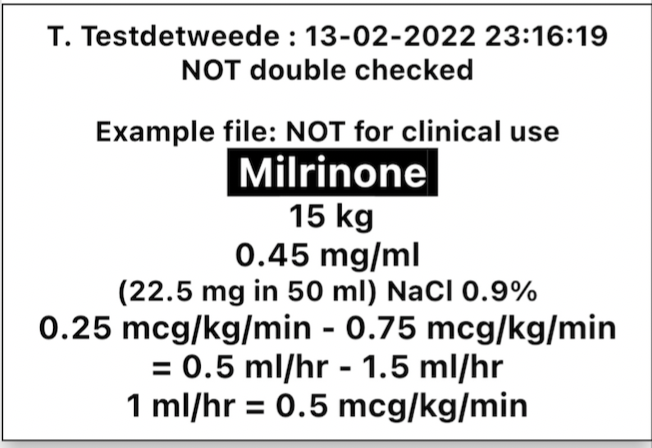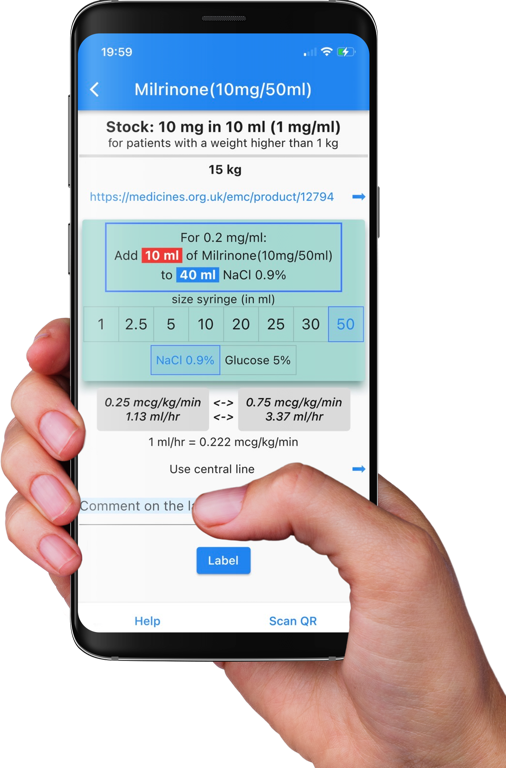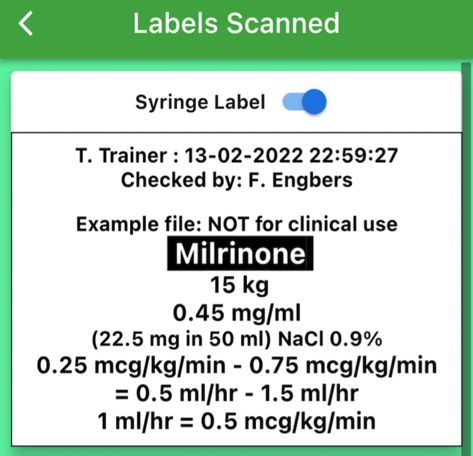¶ What is LabelSyringe
LabelSyringe is for one part a smartphone app running on Android and IOS, the other part is a web based editing system to generate the information that is used in the smartphone app. Its purpose is to generate extended labels for syringes that are prepared in the Operating Theatre or Intensive Care Unit. The objective is
- to increase readability of the labels on syringes
- Improve the content of information on the label
- improve compliance with department protocols for drug preparation-
- reduce medication errors by supporting calculations for weight based dilution adaptations
- enhance information exchange between the departments: for example from pharmacology to end users and in-between end users for example the OR and ICU
- increase effectiveness of double check protocols by using QR codes.
- reduce costs by avoiding waste of expensive preprinted labels.
¶ 1 Readability of labels on syringes
No long argumentation is required to demonstrate that printed characters are usually more readable than handwritten text. Every health care worker will recognise the situation where the dilution in the syringe or other content information is hardly readable. It can even sometimes be a challenge to read the name of the drug itself. In addition, although the format of the label often is dictated by department rules, the way these rules are applied may vary widely between users and or departments.
¶ 2 Improve the content of information on the label
The necessity of having the drug name and dilution available on the label is obvious. The label in labelSyringe also prints the dosing range according to the departments protocol which is automatically calculated to the infusion range in ml/hr. This allows for swift recognition of infusions that are outside the range that is considered to be normal. In addition the label in labelSyringe includes identification of the patient and the weight of the patient. Furthermore exact time of preparation and preparation preparer is available. If double checking is required then the person that double checked the preparation before printing is also identified.

¶ 3 Improve compliance with department protocols for drug preparation
Everyone in a department who is involved with preparing drugs at the work floor has his or her little book(or electronic notes these days?) with drug dilution and dosing protocols that are used by the department. Having a centrally managed database of these protocols is obviously an advantage. Users will have easily access to changes that are made in the database. In future releases of labelSyringe users will automatically be notified about for example new drugs and how to prepare them. New personal can be granted access to the database from day one they start working. If the working area spannes more than one department users can select the file with protocols that belong to these different working areas.
¶ 4 Support for preparing dilutions

Instructions for the preparation of the drug is a valuable extension of the software. Specially calculations for dilution of drugs on paediatric departments can be complex.
On some departments the dilution for a range of weights is the same so the dose/time in ml/hr differs for patients with different weight, on other departments the dilutions are weight based which has the advantage that a certain rate in ml/hr delivers the same dose/kg/time. But the last approach is more error prone as for every patient the dilution is than different if the weight is different.
Labelsyringe supports both approaches making it possible to have for example a weight based dilution and ranged based dilution in one drug record dependent on the weight of the patient. Labelsyringe will automatically select the appropriate dilution protocol based on the weight of the patient. And of course you can edit the settings according to the protocol that is used on your department.
If required the editor can provide links to information on the drug like a monograph or the Summary of Product Characteristics (SmPC) from the drug manufacturer. The information can be on the internet or on the local computer of the department.
The user will alway be informed on the person that created the drug record and the time and date of the creation
¶ 5 Double check

Often double check procedures are required for drugs that are prepared at the site of care. One person prepares the drug and the other checks this preparation and label and both then sign the label.
In labelSyringe this double check is implemented by the use of QR codes. Instead of producing a label, the initial preparer generates a QR code. This code is then scanned by a colleague who will print the label after checking the correctness of the preparation. The name of both persons will be printed on the label making it possible to backtrack the procedure in case of an error. When the departments chooses so, the information can be used for quality control, educational purposes, supply information etc. The app is available for iPhone, IPad and android phones.
¶ 6 Preparing your drug database
You will need to invest some time in setting up your own drug database edit the settings . This might also be a good moment to go through your drug preparation protocols and clean up or adjust these protocols to your needs. One thing you will learn: there are no (international) standards so pick your protocols wisely. You can start with copying existing example records, they stem from protocols used in a variety of anaesthesiology departments but you will have to make sure that these examples comply with your daily practice. For editing your database you will have to use a desktop or laptop computer. Once you have made an account for labelSyringe either for the editor environment or the smartphone app you will have to use the identical login for using and editing the database. If you want colleagues to use your database you will have to send us an email so we can discuss how to help you to set up a departmental implementation of the software.
¶ 7 Costs
For single users the app is at the moment free to use. If you want to implement the software in your department with multiple users then please contact us. In addition, if you have special requirements then please let us know. We are convinced that our software will help in reducing medication errors and so will leverage the safety of our patients, but we need your input and feedback to fine-tune and improve the software to maximise its potentials.
¶ 8 Contact
Please contact us at mailto:labelSyringe@gutta.tech